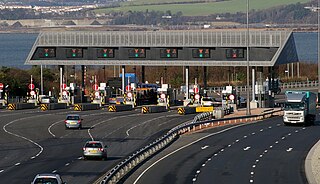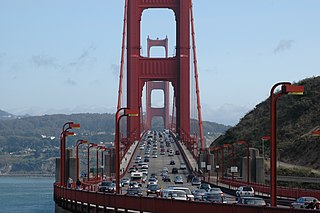
Transport economics is a branch of economics founded in 1959 by American economist John R. Meyer that deals with the allocation of resources within the transport sector. It has strong links to civil engineering. Transport economics differs from some other branches of economics in that the assumption of a spaceless, instantaneous economy does not hold. People and goods flow over networks at certain speeds. Demands peak. Advance ticket purchase is often induced by lower fares. The networks themselves may or may not be competitive. A single trip may require the bundling of services provided by several firms, agencies and modes.

A toll road, also known as a turnpike or tollway, is a public or private road for which a fee is assessed for passage. It is a form of road pricing typically implemented to help recoup the costs of road construction and maintenance.

Road pricing are direct charges levied for the use of roads, including road tolls, distance or time-based fees, congestion charges and charges designed to discourage the use of certain classes of vehicle, fuel sources or more polluting vehicles. These charges may be used primarily for revenue generation, usually for road infrastructure financing, or as a transportation demand management tool to reduce peak hour travel and the associated traffic congestion or other social and environmental negative externalities associated with road travel such as air pollution, greenhouse gas emissions, visual intrusion, noise pollution and road traffic collisions.

Congestion pricing or congestion charges is a system of surcharging users of public goods that are subject to congestion through excess demand, such as through higher peak charges for use of bus services, electricity, metros, railways, telephones, and road pricing to reduce traffic congestion; airlines and shipping companies may be charged higher fees for slots at airports and through canals at busy times. Advocates claim this pricing strategy regulates demand, making it possible to manage congestion without increasing supply.

The Singapore Area Licensing Scheme (ALS), was a road pricing scheme introduced from 1975 to 1998 that charged drivers who were entering downtown Singapore, and thereby aimed to manage traffic demand. This was the first urban traffic congestion pricing scheme to be successfully implemented in the world. This scheme affected all roads entering a 6-square-kilometre area in the Central Business District (CBD) called the "Restricted Zone" (RZ), later increased to 7.25 square kilometres to include areas that later became commercial in nature. The scheme was later replaced in 1998 by the Electronic Road Pricing.

Electronic toll collection (ETC) is a wireless system to automatically collect the usage fee or toll charged to vehicles using toll roads, HOV lanes, toll bridges, and toll tunnels. It is a faster alternative which is replacing toll booths, where vehicles must stop and the driver manually pays the toll with cash or a card. In most systems, vehicles using the system are equipped with an automated radio transponder device. When the vehicle passes a roadside toll reader device, a radio signal from the reader triggers the transponder, which transmits back an identifying number which registers the vehicle's use of the road, and an electronic payment system charges the user the toll.

Toll Collect GmbH is a German company that has developed and is running the tolling system for trucks (LKW-Maut) on German motorways.

The Electronic Road Pricing (ERP) system is an electronic toll collection scheme adopted in Singapore to manage traffic by way of road pricing, and as a usage-based taxation mechanism to complement the purchase-based Certificate of Entitlement system. There are a total of 93 ERP gantries located throughout the country, along expressways and roads leading towards the Central Area. As of February 2023, there were a total of 19 ERP gantries in operation, as compared to 77 in 2020 before the COVID-19 pandemic in Singapore.
Dedicated short-range communications (DSRC) is a technology for direct wireless exchange of vehicle-to-everything (V2X) and other intelligent transportation systems (ITS) data between vehicles, other road users, and roadside infrastructure. DSRC, which can be used for both one- and two-way data exchanges, uses channels in the licensed 5.9 GHz band. DSRC is based on IEEE 802.11p.

Open road tolling (ORT), also called all-electronic tolling, cashless tolling, or free-flow tolling, is the collection of tolls on toll roads without the use of toll booths. An electronic toll collection system is usually used instead. The major advantage to ORT is that users are able to drive through the toll plaza at highway speeds without having to slow down to pay the toll. In some installations, ORT may also reduce congestion at the plazas by allowing more vehicles per hour/per lane.

Transportation demand management or travel demand management (TDM) is the application of strategies and policies to increase the efficiency of transportation systems, that reduce travel demand, or to redistribute this demand in space or in time.

A toll road is a road over which users may travel over on payment of a toll, or fee. Tolls are a form of use tax that pays for the cost of road construction and maintenance, without raising taxes on non-users. Investor's bonds necessary for the construction of the roads are issued and sold with the expectation that the bonds will be paid back with user tolls. The toll roads may be run by government agencies that have bond issuing authority and/or private companies that sell bonds or have other sources of finance. Toll roads are usually a government guaranteed road monopoly that guarantees limited or no competing roads will be built by government agencies for the duration of the bonds. Private toll roads built with money raised from private investors in expectation of making money from the tolls probably dominated early toll roads. Government sponsored toll roads often guarantee a minimum payment to the bond holders if traffic volume and toll collections are less than predicted. If the toll authority is a private company there is often a maximum amount of fees that they may extract from users. Toll road operators are typically responsible for maintaining the roads. After the bonds are paid off the road typically reverts to the government agency that authorized the road and owns the land it was built on. Like most government taxes it is not unusual for tolls to continue to be charged after the bonds have been paid off.

The HGV toll is the tolling scheme for heavy goods vehicles traversing Autobahn road usage with trucks. Charges are based on the distance driven in kilometres, the emission category of the vehicle and the number of axles.

San Francisco congestion pricing is a proposed traffic congestion user fee for vehicles traveling into the most congested areas of the city of San Francisco at certain periods of peak demand. The charge would be combined with other traffic reduction projects. The proposed congestion pricing charge is part of a mobility and pricing study being carried out by the San Francisco County Transportation Authority (SFCTA) to reduce congestion at and near central locations and to reduce its associated environmental impacts, including cutting greenhouse gas emissions. The funds raised through the charge will be used for public transit improvement projects, and for pedestrian and bike infrastructure and enhancements.
A vehicle miles traveled tax, also frequently referred to as a VMT tax, VMT fee, mileage-based fee, or road user charge, is a policy of charging motorists based on how many miles they have traveled.

A high-occupancy toll lane is a type of traffic lane or roadway that is available to high-occupancy vehicles and other exempt vehicles without charge; other vehicles are required to pay a variable fee that is adjusted in response to demand. Unlike toll roads, drivers have an option to use general purpose lanes, on which a fee is not charged. Express toll lanes, which are less common, operate along similar lines, but do not exempt high-occupancy vehicles.
The multi-lane free flow(MLFF) is a system that allows free-flow high-speed tolling for all highway users. With MLFF, current toll lanes at toll plazas can be replaced with ordinary multilane road segments. By using tags with readers at gantry across the highway to detect vehicles and deduct tolls using the existing Electronic Toll Collection (ETC) when fully implemented. Using only video and automatic license plate recognition it is also possible to have a MLFF system without using tags and readers. This type of solution is implemented in Stockholm for congestion charging purposes.
Platon is an electronic toll collection system established in Russia in November 2015. The toll is collected from trucks over 12 tonnes, with the proceedings going to a federal fund for road maintenance. A subsidiary of the state-owned Rostec corporation holds a 50% stake in the collection system operator, with the Putin-associated Rotenberg oligarchs owning the other half.

EasyGo is a joint venture between Norway, Sweden, Denmark and Austria, that enables use of a single electronic toll tag on toll roads, ferries and bridges in all the member countries. The purpose of EasyGo is to enable the use of one OBE for payment when driving through any toll facility one might encounter on the way through Northern Europe and Austria.

A toll is a fee charged for the use of a road or waterway.
















